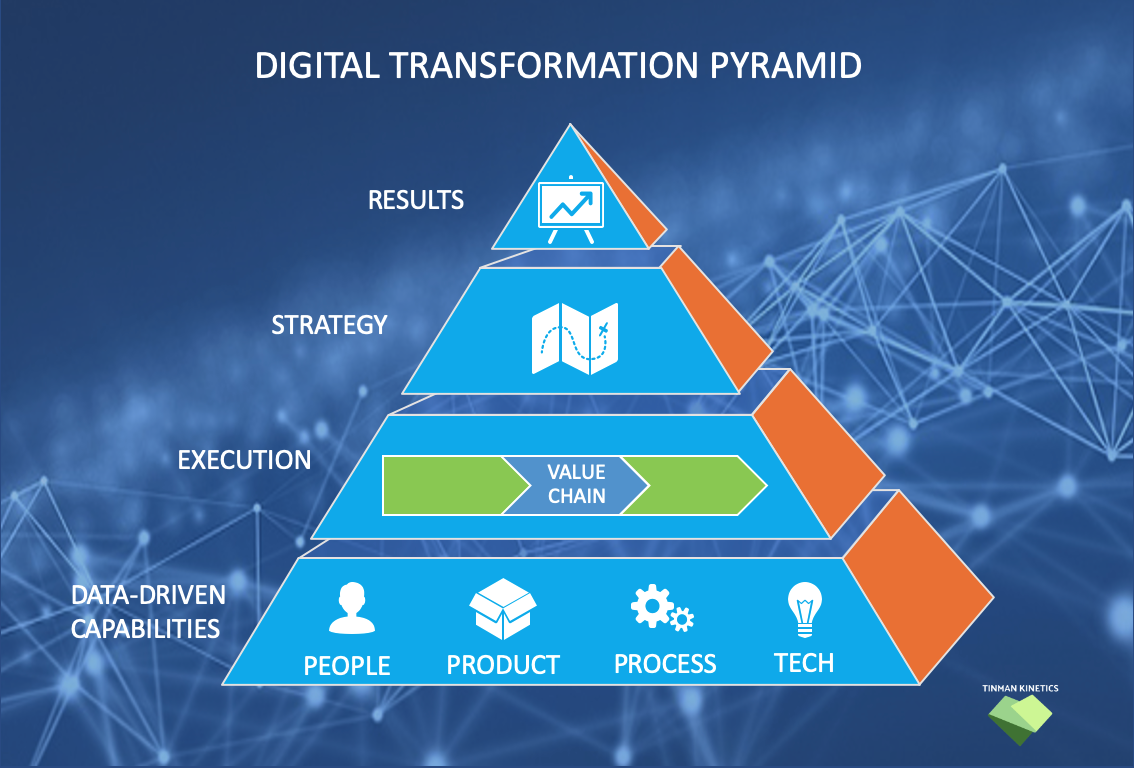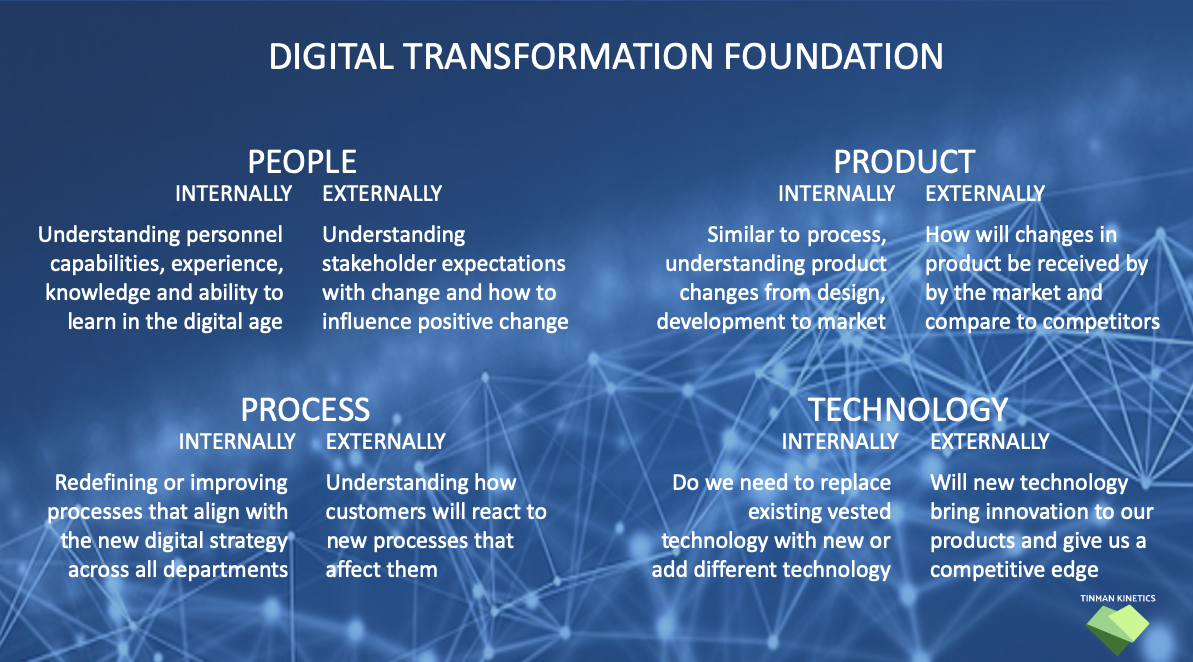WHAT IS DIGITAL TRANSFORMATION? IT’S EMBRACING CHANGE
First of all, digital transformation is not just about technology. That is the first thing that comes to mind when people think about digital transformation and becoming “digital”. This thinking usually includes what’s the new and latest gadgets that will automatically and magically transform a company into something better.
But the reality is that digital transformation is really about redefining your strategy and cultural mindset or an easy way to say this is, it’s about embracing change and this change starts with understanding where an organization is within its digital transformation maturity model. This “change” approach is best explained through the digital transformation pyramid framework.

Like any pyramid, it starts with the foundation and this foundation is about data-driven capabilities. We know that every person creates data and this data is in the form of selfies, videos, blogs, text messages, etc. Well, the same applies to organizations. Organizations create not just data but lots of data. But the goal is how do we use this data to create value or as I like to say, how do we turn data into digital assets. An asset that brings intrinsic value that can be financial, emotional or intellectual. These data-driven capabilities that lay the foundation to digital transformation include People, Product, Process and Technology. Each one alone limits an organization, but all together in orchestration, then the true value of data transforms an organization, hence the term digital transformation. It is important also to understand that as we look at each part that there are always two-sides to each one of these data-driven capabilities. One side is internal facing to an organization, as to embrace change within the organization. The other side is public facing, which includes customers, investors, enthusiasts and the general public. I always recommend the first step in digital transformation should start internally within an organization because only successful change internally can produce the right results externally.
Digital Transformation is about
PEOPLE
PROCESS
PRODUCT
TECHNOLOGY

People
The key to any organization is people. Without the right people, any organization will fail. Digital Transformation takes a look at the existing personnel, their roles and skill sets.
First, we must assess the maturity level of personnel within the organization. Do they currently possess the proper experience and knowledge to execute digital transformation initiatives? Do they require more training, can they be trained, or should new personnel be brought in to achieve the set goals? Part of this approach with personnel is also understanding throughout this process is the cultural shift that takes place when an organization becomes digital. The first question seems to be, am I going to lose my job? There are many methods to help address these expected challenges during a cultural shift with the main approach to be proactive and not reactive.
The other side with people becomes the external component in digital transformation and this usually is associated with the customer. As organizations embrace digital transformation, this same approach internally must also be applied externally. This is really about understanding the customer, how they use your product and how they will be affected by digital transformation changes such as integrating new technology. Traditionally, these changes are positive as customers tend to embrace positive change, but time must still be taken to understand its impacts and how to benefit from these changes.
Process
Processes change as often as organizations and customers change. Today, the most talked about processes include lean, agile and more traditional methods such as SixSigma. As with change management, a new strategy means adjusting, creating, developing and initiating process to create better efficiencies.
Internally with digital transformation, it is applying the same approach with the new digital strategy and asking the questions, what changes in process are needed such as improving an old process or creating new ones to adapt to the tasks at hand. Process changes should start out small but gradually expand across departments to fully embrace the new digital strategy.
Externally, it is about process with stakeholders outside the organization such as suppliers, vendors, partners and customers. This could be a vendor management solution that requires new processes and will involve training your vendors on how to use but it also means feedback from your stakeholders on the ease of use, efficiency and purpose of the system. Any process change should always include a feedback loop to continually improve for all stakeholders
Product
You are only as good as your product and his holds true for any successful organization. Digital transformation definitely embraces change with product in mind. Customers buy your product because it helps solve a problem, but today there are a lot of organizations that are making similar products to help solve that same problem, so how do you stand out? This usually involves improving your product to connect with your changing customers. Digital transformation helps improve your product, if done properly.
Internally like process, it is understanding what the product does, how it’s built, time to market, how difficult to make upgrades or changes, the resources needed, all in order to make the proper change to align with the digital strategy.
Externally, its understanding how changes in product will be received by the market, not just customers. It also takes a deeper look at your product against competitors to properly evaluate value proposition and positioning.
Technology
We sometimes feel like we are a little kid in the candy store when it comes to new technology. It’s cool, fun, new, exciting and believe it will take an organization to new heights. As I said before, it’s like magic. This is where many people fall into the trap of SOS or Shiny Object Syndrome. We see a new shiny object and our eyes and wallets are wide open. This is especially true after returning from events such as CES (Consumer Electronics Show) in Las Vegas or Mobile World Congress in Barcelona.
In digital transformation, we need to first step back from any new technology and internally evaluate what existing technology is in place within an organization. The key here is understanding what technology is in place and more importantly how much time, effort and resources are already vested in that technology. The second part of this is to ask if we are bringing in new technology, will it be a substitute, or will it replace existing technology. The last thing anyone wants to do is bring in new technology to replace existing when that existing technology ROI is still not in reach.
Externally, it is really understanding how new technology will bring innovation to the organization. This innovation could be within the organization or it could be within existing product or even create a new product. Also, will this technology give the product a competitive advantage, meet a new market need, or just be trendy. Technology is a big investment, so thorough evaluation must be considered before making any decisions.
It’s all Connected. The Cultural Mindset Change.
We all realize that alone, each one of these data-driven capabilities bring limited value when understanding the digital challenges organizations face, but together and aligned by strategy and framework, then it’s a different story. But we still need to take this one set further. All of these data-driven capabilities require a progressive approach to be successful. Needed is the cultural mindset change to continually promote adoption, reduce uncertainty and foster innovation, all leading to a better organization and better customer experience.
Subscribe to Tinman Kinetics
Get the latest posts delivered right to your inbox
